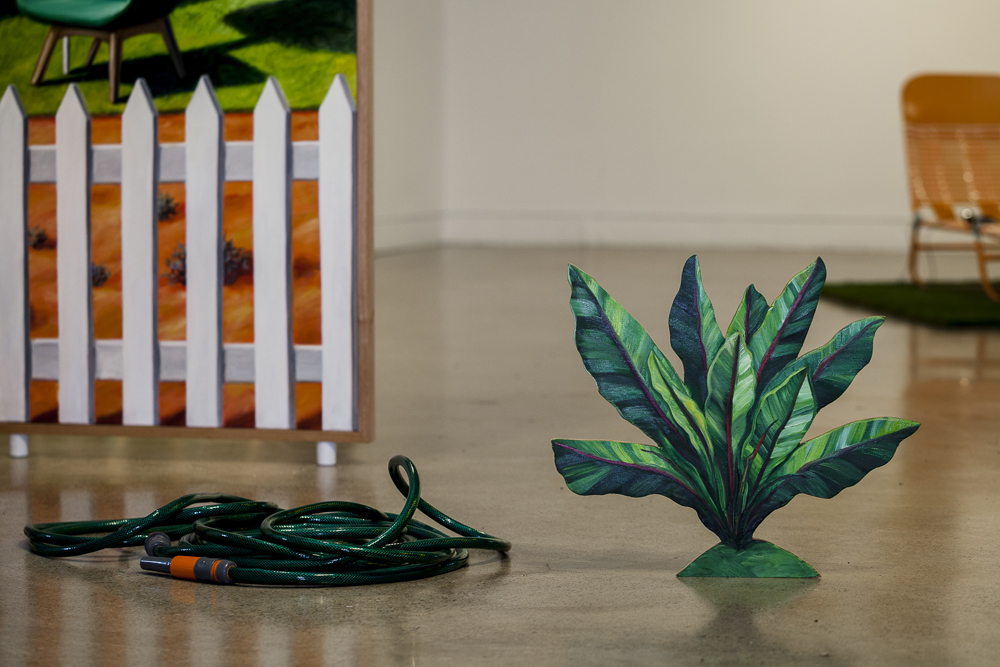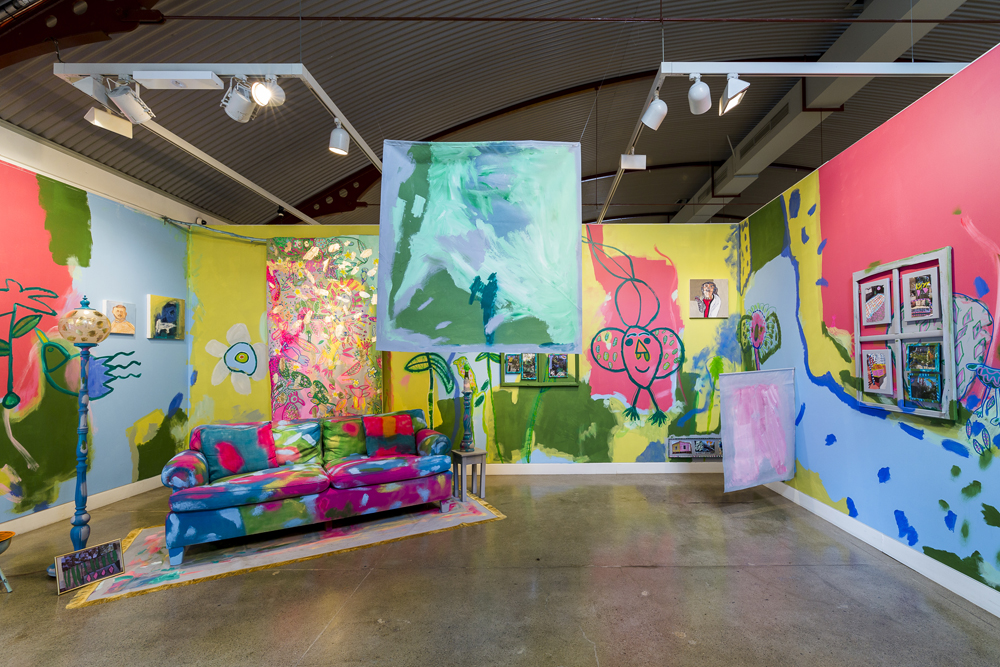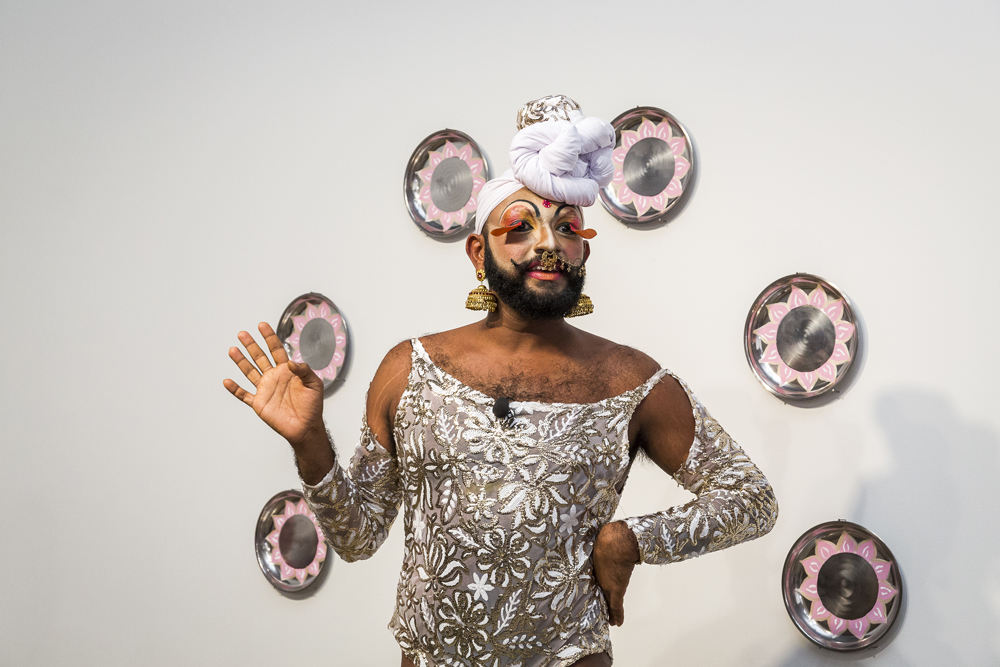Suburbia

By Paul Kelaita
26 April, 2018
My mum’s voice rings out a warning-slash-admonishment in my head: ‘Make sure the stove is off.’
Even though I check regularly, responsibly, maybe excessively, sometimes I don’t trust myself. Other times I’m so lost in thought when checking the stove that I don’t actually check it. It’s this minor, but pervasive, homely anxiety that greets visitors to Suburbia, the inaugural exhibition at Cement Fondu.
Crowning the stairs to the exhibition space is Biljana Jancic’s ‘Anxiety Daily (For Rupert)’ (2018), a fabric print of two red-hot stove coils. This homely and homey reference point brings us all together in shared experience, but there’s something about the work that implies that a universal experience of ‘suburbia’ may really be partial. Whilst the source of our anxiety is the burning stove top, the minimal and striking pattern of two orange-red spirals specifically reads as slick inner-city design. This is a bougie design aesthetic that is well-aligned with contemporary Paddington—Cement Fondu’s geographical home.
There are many ways to read Suburbia. Curators Megan Monte and Josephine Skinner have constructed the exhibition around the universality and porousness of our Australian suburban imaginary. For me, it’s the relay between the suburbs (out there) and the city (which is configured here as a local rendition of suburbia) that evokes this slipperiness. It’s because of this back and forth that we are able to see how our understandings of Paddington, and other inner-city suburbs, are maintained through very different visual and cultural codes than say Campbelltown, or Fairfield, or Penrith.

Project Space: Studio A with Rosie Deacon, Tree Top Tweety Bird Pop Egg Design Living (2018)
mixed media installation
Portraits of neighbours throughout, various Studio A artists.
Image Credit: Document Photography
If ‘Anxiety Daily (For Rupert)’ engages with the idea of Paddington, ‘Tree Top Tweety Bird Pop Egg Design Living’ (2018) by Rosie Deacon and Emily Crockford engages with its materiality. The project space is wall-to-wall colour, with more colourful paintings hanging from the ceiling and jutting out from the wall. In the middle of this sits a sofa almost exploding with intense shades of blue, pink, and green. The warmly immersive installation is fun, but it’s also spectacular, with the artists translating their own experience of the local area’s trees and wildlife into glorious aesthetic excess. Lining the walls are also portraits of the gallery’s neighbours by Studio A artists. This is the Paddington of today—its landscapes and people and million-dollar terraces—reimagined in Deacon and Crockford’s world of colour.
Whilst it may once have been designated as the city-fringe, Paddington is now classified as a suburb, albeit in a very different rendition than that of Leumeah, or Abbotsbury, or Bringelly. For one, you have almost definitely heard of it. It’s also a different kind of ‘different’ than it was five or ten or twenty years ago when it was still the pulsing centre of gay Sydney.
With this in mind, and my own searching eye, I can’t help but zero in on the gay stuff that speaks to this particular history of Paddington. Radha La Bia’s opening night performance delivered all my favourite things: a gay, brown, suburban spectacle which simultaneously blends together and escapes the fixing of any of its parts. The performance was titled the Tamil word ஒன்பது (2018) which, as the artist explains, translates to nine but is also used to mean faggot.

Shahmen Suku | Rahda La Bia, ஒன்பது (Nine) (2018)
performance and installation
Image Credit: Document Photography
The performance unfolds with Shahmen Suku in his be-glittered, be-jewelled, and bearded glory as Radha La Bia—the Diva from India who is actually from Singapore. La Bia stands before us in a silver, applique leotard with hairy chest and shoulders peaking through as she slowly unstacks a nine-tiered tiffin carrier. Emptying the contents onto a large banana leaf, the diva explains the food, talking us through family and culture, and not really remembering ever being called ‘nine’.
The performance is both camp spectacle and measured restraint: La Bia slowly walks us through the process while seductively batting her flower-petal eyelashes and throwing in references to shit and piss and vomit and lube. In an exhibition saturated with suburban imagery, this is the only work premised on a front-facing queerness, one that is delicately brought together with the brown body and narratives around migration and food. The relay between a suburban ‘here’ and ‘there’ is poked and prodded and poured in ஒன்பது.
Perhaps because of my own commitments I approach Suburbia less as a space of shared universals and nostalgia than as a comment on origins, spaces, and difference. In this inner-city context, and as my focus has betrayed, I respond most to the works that are fun, spectacular, and a bit biting: three things often excluded from ideas of the suburbs. These are the works that move between the ‘out there’ and the ‘in here’, that pull away from the lawns and the quarter-acre-blocks, that traffic between the origins and histories and porous boundaries of suburban space.